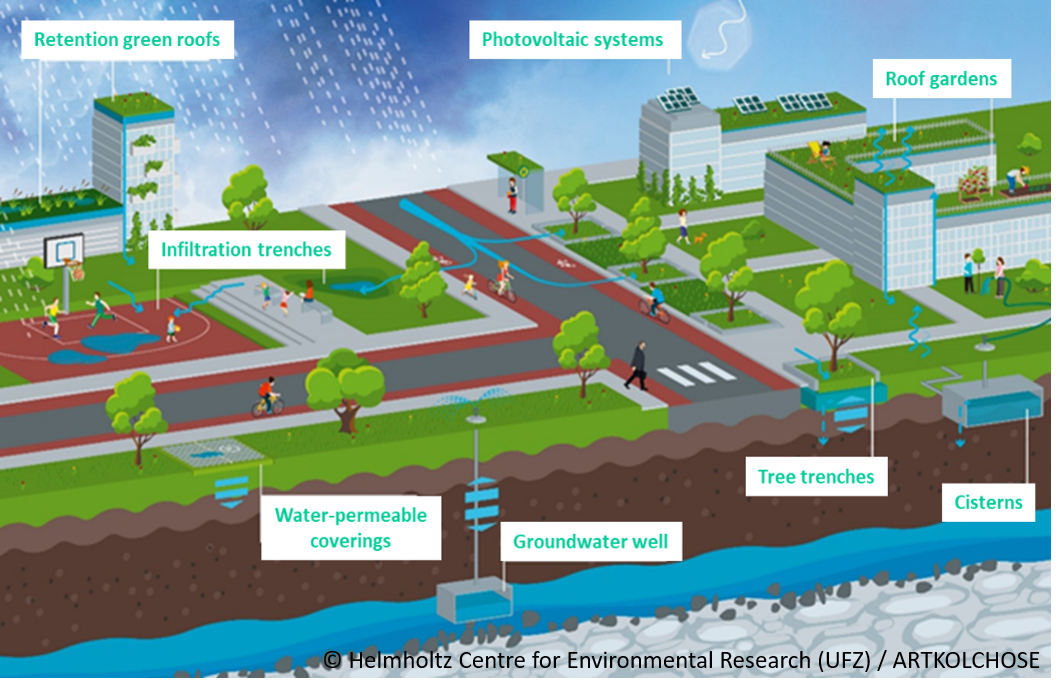
Department Systemic Environmental Biotechnology (SUBT)
Challenge for the SUBT: Adaptation and Mitigation of Cities to the Impacts of Climate Change
Cities are both major contributors to and particularly vulnerable to the impacts of climate change on a global scale. Although they occupy only 3% of the Earth's surface, they consume around 75% of natural resources. This concentration makes cities central players in climate protection, while at the same time, their economic and social functionality is highly threatened by the effects of climate change.
Our Vision
The vision of the SUBT Department – Systemic Environmental Biotechnology – is to decisively support urban areas in their transition toward a carbon-neutral and climate-resilient society. We achieve this by developing and implementing innovative concepts, technologies, and system solutions that are applied in both adaptation and mitigation processes. Central to this is the establishment of integrated Blue-Green-Red infrastructure and urban development concepts that combine ecological, social, and technical aspects.
Our research focuses on the following key questions:
- Technological Potential: How can microbiological and nature-based technologies and systems be specifically utilized for urban adaptation and mitigation scenarios? What resources are available within urban areas and their surrounding regions?
- Integrated Planning: How can Blue-Green technologies and concepts be incorporated into an integrated infrastructure and urban planning approach and implemented as part of the “Water Turnaround”?
- Creating Synergies: How can synergies between water management and energy development in urban areas be fostered?
- Implementation of Innovations: How can scientific innovations—such as technologies and water management scenarios—not only be developed but also applied nationally and internationally in urban contexts?
- Effective Collaboration: How can collaboration with decision-makers from business, politics, associations, and authorities be effectively organized to achieve these goals?
A distinctive strength of the SUBT Department is its integration of technology-driven research on multifunctional Blue-Green technologies with spatial economic planning methods for water-sensitive infrastructures. To facilitate climate-resilient Blue-Green infrastructure planning, we design and apply advanced modeling tools that offer critical insights, such as the prioritization of action plans for urban infrastructure and city development.
Given the complexity of this research, our approach is deeply interdisciplinary, involving close collaboration across scientific, industrial, and administrative sectors. One example is our work in aligning technological advancements with legal frameworks to establish the necessary regulatory conditions ( Policy Papier - Urbane Wasserwende ).
Additionally, we are developing SolutionLabs, which act as hubs for the testing, validation, and optimization of technologies, products, services, and educational initiatives. These labs bring together stakeholders from academia, industry, and society. A notable success from such collaborative efforts is the establishment of Leipzig as a German model city for resource-efficient urban development ( Research project Leipziger BlauGrün ).
Collaboration with the German Association of Cities and other model cities also aims to anchor research results in the real world, incorporate transdisciplinary aspects, and deliver the synthesis of our findings for cities and municipalities in Germany and beyond.
The described issues are addressed by three working groups:
The 'Environmental and Bioprocess Engineering' working group focuses on the development, optimization, and implementation of decentralized environmental technologies in urban areas. This work utilizes specialized research infrastructures, such as green roofs. Our technology-oriented research topics include the investigation of the multifunctional effects of Blue-Green water infrastructures and the development of biorefinery processes aimed at resource-efficient stabilization of biogas processes.
The working group 'Water-Sensitive Infrastructure Planning' (WASP) focuses on developing spatial-economic planning methods for water-sensitive infrastructure. Their work spans various scales, from the settlement and neighborhood level to regional, national, and international levels.
The 'Integrated Bioprocesses' working group designs, develops and implements robust, scalable and bio-based processes to increase resource efficiency by preferential use of residues and wastewater. The focus is on the use of non-conventional yeasts for the sustainable production of industry-relevant carboxylic acids as part of a circular bio-economy. Sustainability assessment tools are integrated into process development to identify ecological at an early stage.
